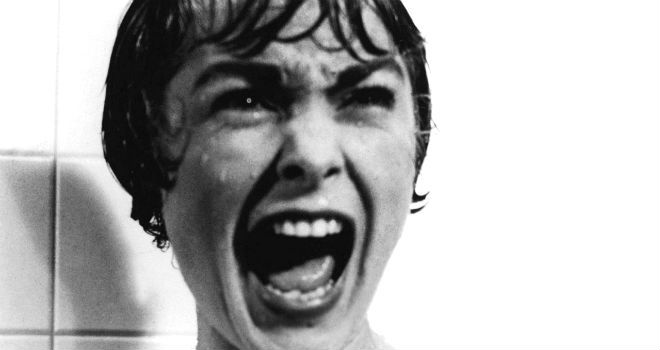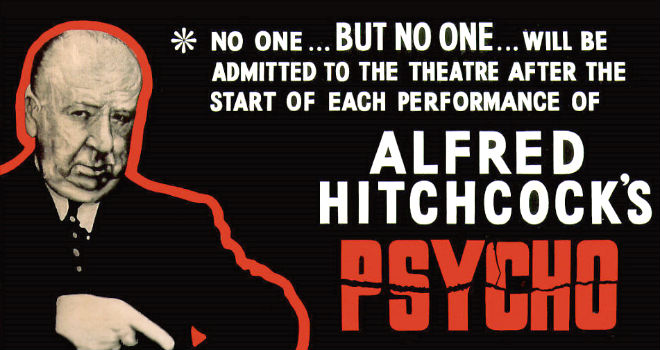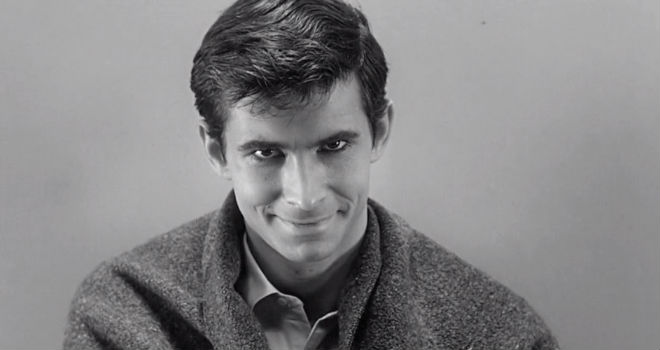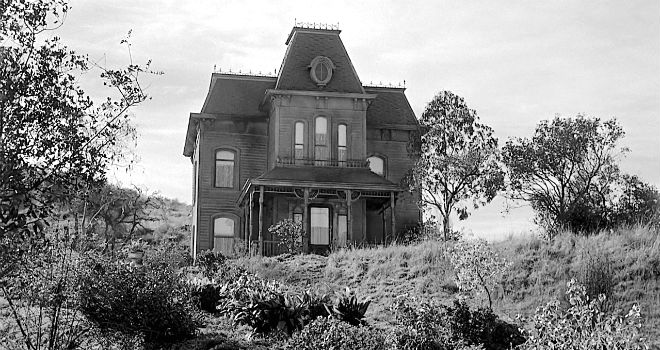 Besides making people forever afraid of motel-room showers, Alfred Hitchcock's "Psycho" continues to have an incalculable impact on popular culture. Though it was released 55 years ago this week (on June 16, 1960), it continues to inspire filmmakers and TV producers. In just the last three years, we've seen the 2012 film "Hitchcock" (based on Stephen Rebello's book "Alfred Hitchcock and the Making of 'Psycho,'" and starring Anthony Hopkins as the director and Scarlett Johansson as Janet Leigh) and the ongoing A&E TV prequel drama series, "Bates Motel."
Besides making people forever afraid of motel-room showers, Alfred Hitchcock's "Psycho" continues to have an incalculable impact on popular culture. Though it was released 55 years ago this week (on June 16, 1960), it continues to inspire filmmakers and TV producers. In just the last three years, we've seen the 2012 film "Hitchcock" (based on Stephen Rebello's book "Alfred Hitchcock and the Making of 'Psycho,'" and starring Anthony Hopkins as the director and Scarlett Johansson as Janet Leigh) and the ongoing A&E TV prequel drama series, "Bates Motel."Still, for all of the "Psycho" trivia revealed in "Hitchcock," the biopic barely scratches the surface of how the film got made, from the men who inspired the invention of Norman Bates, to the trickery Hitchcock used to tease the press while keeping the film's convention-shredding narrative twists a secret, to the film's unlikely connection to "Leave It to Beaver." Here, then, are 25 of the secrets behind "Psycho."
 1. The film is based on Robert Bloch's novel, which was inspired by Ed Gein, the 1950s Wisconsin serial killer whose case would also inspire such movie murderers as Leatherface (in "The Texas Chainsaw Massacre" franchise) and Buffalo Bill (in "The Silence of the Lambs"). Bloch lived just 40 miles from where Gein's murders took place.
1. The film is based on Robert Bloch's novel, which was inspired by Ed Gein, the 1950s Wisconsin serial killer whose case would also inspire such movie murderers as Leatherface (in "The Texas Chainsaw Massacre" franchise) and Buffalo Bill (in "The Silence of the Lambs"). Bloch lived just 40 miles from where Gein's murders took place.2. Another long-rumored inspiration for Bloch's Norman Bates was Calvin Thomas Beck, the middle-aged, bespectacled publisher of the magazine Castle of Frankenstein, who was accompanied everywhere by his smothering mother. Besides the mother-son closeness, the Norman of the novel -- depicted by Bloch as 40-ish, bespectacled, and portly -- more closely resembled Beck than he did Gein or, for that matter, the young and handsome Anthony Perkins.
3. Bloch netted just $5,000 for the sale of the film rights to his novel.
4. A 1959 rumor had Hitchcock buying up all available copies of Bloch's novel in order to preserve the secrecy surrounding his forthcoming movie's plot.
5. One journalist reported the then-top secret film's title to be "Psyche," which prompted rumors that Hitchcock's film had something to do with Greek mythology.
6. To appease the press, Hitchcock claimed that the film would tell the story of "a young man whose mother is a homicidal maniac."
 7. He also claimed that, for the role of the mother, he considered casting a theatrical grande dame, someone like Helen Hayes or Judith Anderson (who had played the unforgettably creepy Mrs. Danvers in Hitchcock's "Rebecca.") Norma Varden, the old woman whom Robert Walker nearly chokes to death in Hitchcock's "Strangers on a Train," read the reports and lobbied the director for the role of Mrs. Bates.
7. He also claimed that, for the role of the mother, he considered casting a theatrical grande dame, someone like Helen Hayes or Judith Anderson (who had played the unforgettably creepy Mrs. Danvers in Hitchcock's "Rebecca.") Norma Varden, the old woman whom Robert Walker nearly chokes to death in Hitchcock's "Strangers on a Train," read the reports and lobbied the director for the role of Mrs. Bates.8. Still, Hitchcock refused to release a plot synopsis to the press, something that was unheard of in those days before "spoiler alert" culture. The only other director who had ever done that was Cecil B. DeMille, who refused to tell reporters the plot of "The Ten Commandments." (Did he really think no one could guess that one?)
9. Hitchcock did, however, let reporters know that a young woman would be murdered in a shower. Asked how he'd get this sequence past the censors, he told the New York Times, "Men do kill nude women, you know."
10. In another tease, Hitchcock allowed the leak of photos from the set of a director's chair emblazoned with the name "Mrs. Bates." There were individual photos of Hitchcock and every major cast member taking turns sitting in the chair -- everyone, that is, except for Perkins.
11. Hitchcock considered Dina Merrill for the role of Marion Crane, but ultimately nixed her as "attractive but too starchy. Too much forehead." Of course, Merrill also wasn't as big a name as Janet Leigh, whose star status helped keep the audience from suspecting that she'd be killed off before the movie was half over.
 12. The shower murder is one of the most studied montages of film editing ever made. It contains at least 70 edits in just 45 seconds.
12. The shower murder is one of the most studied montages of film editing ever made. It contains at least 70 edits in just 45 seconds.13. The cuts are so fast that many viewers believe they've spotted Janet Leigh's nipples (they haven't, though Hitchcock did use Marti Renfro as a nude body double for Leigh in some shots). They also thought they saw multiple frames of the knife piercing her flesh (in fact, it's shown touching her flesh just once).
14. For Leigh's blood, which swirled down the shower drain, Hitchcock used Bosco chocolate syrup.
15. Some viewers have sworn they saw red blood in the shower scene. They may be confusing their memories of "Psycho" with those of William Castle's "The Tingler," a horror film from 1959, which does have a shot of a red, blood-drenched bathtub in an otherwise black-and-white sequence.
16. An urban legend has it that Leigh's screams were prompted by Hitchcock shocking her with cold shower water. Leigh denied this in her memoir, insisting that Hitchcock kept the water warm and comfortable, as the sequence took a whole week to shoot.
17. To create the sound effect of the knife stabbing flesh, Hitchcock sent prop man Bob Bone out to fetch a variety of melons. The director then closed his eyes as Bone took turns stabbing watermelons, casabas, cantaloupes and honeydews. Hitchcock thought about it, opened his eyes to a table covered in fruit gore, and said, "Casaba."
 18. The voice of "Mother" was provided by three different performers, including one man: Paul Jasmin, a character actor and friend of Anthony Perkins. The others were Virginia Gregg and Jeanette Nolan, two frequent guest stars on "Alfred Hitchcock Presents."
18. The voice of "Mother" was provided by three different performers, including one man: Paul Jasmin, a character actor and friend of Anthony Perkins. The others were Virginia Gregg and Jeanette Nolan, two frequent guest stars on "Alfred Hitchcock Presents."19. Jerry Mathers, best known as the child star of the 1950s sitcom "Leave It to Beaver," claims to have had a hand in the creation of the mummified Mrs. Bates. Mathers (who had also appeared in Hitchcock's "The Trouble With Harry") recalled in 2012 that, not only were "Psycho" and "Beaver" shot on the same lot at Universal Studios, but they also shared a makeup artist, Robert Dawn. Mathers wrote on his website that, one day, Dawn brought to the "Beaver" set the skull he would use for Mrs. Bates. He had to glue on the strands of hair one by one. Mathers asked if he could help, and Dawn let him glue a few strands. "As a young boy, I thought, what could be cooler than this?" Mathers wrote.
20. Hitchcock would later mail that skull to Henri Langlois, the famous French film curator, because the filmmaker assumed that, if he gave it to an American museum, "they'd probably sell it or lose it." Langlois, who put it on display at the Musee du Cinema at La Cinematheque in Paris, found a note from the director accompanying the package, saying simply, "I hope you received my gift."
21. The 1957 Ford sedan that Marion drives was also a prop borrowed from "Leave It to Beaver," where it had served as the Cleaver family's car.
22. The then-unknown actor playing Norman's cell guard at the end of the movie is Ted Knight, still a decade away from TV immortality on "The Mary Tyler Moore Show" and two decades away from "Caddyshack."
23. The black-and-white film cost just $800,000 to make, a relative bargain after the series of lavish Technicolor productions Hitchcock had filmed in the 1950s. It grossed some $40 million over the course of several theatrical releases. About $15 million of that went to the director himself, who had sold distributor Paramount on the risky project by deferring his salary in exchange for 60 percent of the net profits.
24. Hitchcock sold the film via an innovative, six-minute trailer, in which the director narrates a mordant crime-scene tour of the Bates Motel and Bates mansion, one that ends with a scene of a screaming woman in a shower that's not actually in the movie. (The woman is "Psycho" co-star Vera Miles, not Janet Leigh.) The trailer also announces the movie's famous policy, which Hitchcock mandated to theater owners, of not admitting anyone into the auditorium after the film has started.
 25. "Psycho" was nominated for four Academy Awards: Best Director, Best Supporting Actress (Leigh), Best Black-and-White Cinematography, and Best Black-and-White Production Design. For all its technical and narrative innovations, "Psycho" didn't win a single Oscar.
25. "Psycho" was nominated for four Academy Awards: Best Director, Best Supporting Actress (Leigh), Best Black-and-White Cinematography, and Best Black-and-White Production Design. For all its technical and narrative innovations, "Psycho" didn't win a single Oscar.